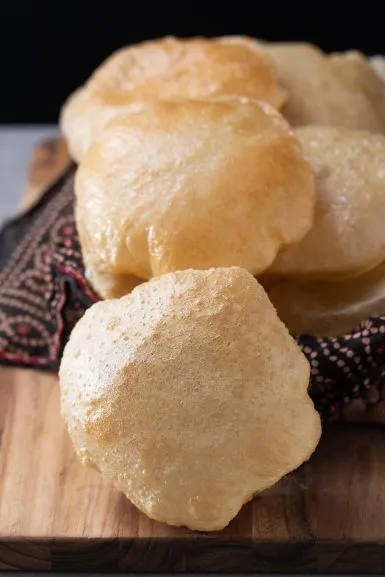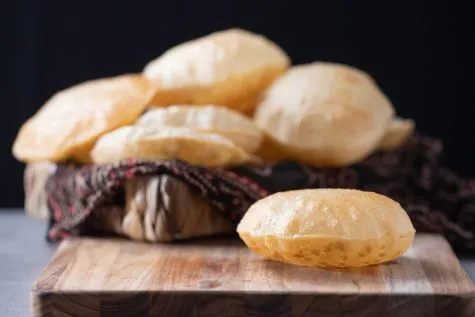Puri is a North Indian balloon bread that is deep-fried. It is often served at parties and gatherings because when you need to make a lot of them, deep frying the bread is a lot faster than making rotli or paratha. This little fry bread is one of my son’s favorites, especially when served with mango ras.
About the Recipe

Puri is a staple in Gujarati households. I grew up learning how to roll puri, well before I was allowed to fry them, starting at about age 5.
We usually made puri when we were going to feed a crowd, when many people were coming over. They are made in a very communal fashion. The women would gather and roll them out, throwing them into a plate that would be frequently swapped out and cooked from.
Puri are relatively easy to make. The great thing about puri is that they don’t stick. You can toss them around, layer them on top of each other as you roll them out, and it won’t ruin the puri.
You may notice my puri are a little on the large side. That is the way my mom taught me to make them. Many families make tiny puris that are about 3” in diameter. My mom always made them at least 4” in diameter because who wants to spend all of that extra time making so many puris? If you want to put in the effort, 3” puris are more traditional.
Ingredients
Chapati flour – Indian whole wheat flour that is finely ground
Oil – for frying, some people would use ghee. Use a neutral oil that can handle a 400°F frying temperature. I like to use avocado oil.
Salt
Ghee
Water
Serving

Puri is served alongside many Gujarati dishes. We eat them with doodh pak, batata nu shaak, bajri or rava halwa, kala chana, and any thali. Any time you might serve roti, you can serve puri in its place.
Puri is often served as prasad. Growing up, a neighbor of mine would serve them by taking two puris, stacking them against each other, and adding kala chana and halwa (rava nu sheero). Served this way, the puri takes away the need for the plate.
Cooking Tips
- Frying oil temperature: you have to get the frying oil temperature just right. If it is too cold, the puris will not puff up and absorb too much oil. If it is too hot, they will brown too quickly and crisp up too much.
- The dough needs to be kneaded to a medium firm dough. It should not be a soft dough or a wet dough. It should neither be dry and crumbly nor wet and sticky.
- If your puri is not puffing, the most likely culprit is puris are too thin, or the oil is not hot enough. You can still use these. Keep adjusting until you get them to puff up for the perfect puri.
- If your puris are collapsing:
- Ensure you cook the second, flipped part long enough. Give it a few extra seconds because it is thicker.
- You may add 1 teaspoon of semolina to the dough to give it more structure to hold the puff longer. This forms a crispier puri, so I prefer not to do this.
- Check that your oil is hot enough. Check the oil by dropping in a small piece of dough. It should bubble up to the surface right away.

Puri
Ingredients
- 2 cups chapati flour finely ground whole wheat flour
- ½ tsp salt or to taste
- 1 ½ tsp ghee
- ¾ cup water may need up to one cup
- 3 cups oil for frying
Instructions
- In a large bowl, combine flour and salt. Then add 1 tsp of ghee and incorporate the ghee into the flour using your fingers. Break up any large clumps of ghee to ensure even distribution.
- Form the dough using small amounts of water at a time. The dough should be medium firm. You do not want a dry or crumbly dough or a wet dough. Form the dough into a log and spread the remaining ½ tsp of ghee on the outside of the dough. Cover and let rest for 15 to 30 minutes. Divide the dough into half, then divide each half into half, and then each section into six parts to reach 24 equal sections.
- Roll each section into a ball and flatten between the palms to form a puck.
- Evenly roll each puck into a 3.5” circle using the roll and rotate technique (see video). You can roll out all the puris before you begin frying. Be sure to keep them covered to prevent the dough from drying out.
- Heat the oil in a stable heavy-bottomed pot to approximately 375°F to 400°F. Test by dropping a small amount of dough into the oil. It should bubble up and rise to the top immediately.
- Add the puri to the hot oil, and gently press on top of the puri with the flat side of the spider (see video). This will help the puri puff up. Cook for about 10 to 15 seconds on the first side and flip. Cook for 15 to 20 seconds on the second side. Remove from oil and serve.
